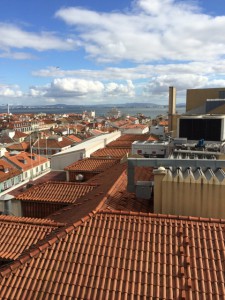Junior Language Challenge: why Portuguese?
The Junior Language Challenge 2015 launched last week, with children all over the UK learning Portuguese in the first round of our national competition. If you’re wondering why we picked Portuguese, here are a few fun facts about one of the world’s most widely spoken languages.
Boa sorte to everyone taking part in the Junior Language Challenge – and if you’re a parent or teacher of children aged 10 or under, take a look at the JLC website to find out more – it’s a lot of fun!
Portuguese facts and figures
 Portuguese is the official language of Brazil, Mozambique, Angola, Portugal, Guinea-Bissau, East Timor, Equatorial Guinea, Cape Verde, and São Tomé and Príncipe.
Portuguese is the official language of Brazil, Mozambique, Angola, Portugal, Guinea-Bissau, East Timor, Equatorial Guinea, Cape Verde, and São Tomé and Príncipe.
It’s a Romance language, along with French, Spanish, Italian and Romanian. This family of modern languages derives from Latin, which was spoken in the Roman Empire – hence the name.
Portuguese is the second most spoken of the Romance languages, after Spanish, and it’s the seventh most widely spoken language in the world. That said, there are significant differences between European and Brazilian Portuguese, so make sure you learn the right one before you travel! (We offer both…)
Portuguese and English
Some Portuguese words that we’ve adopted in English – piranha, flamingo, cobra, albino, palaver, mosquito. Does anyone know any more?
Saudade is a word with no direct English translation, which means a feeling of longing or nostalgia for someone or something that may never return.
Famous Portuguese speakers
José de Sousa Saramago (1922-2010), who won the Nobel Prize in Literature in 1998.
Luís Vaz de Camões (1524-1580), often considered the Portuguese language’s greatest poet, and best known for his epic work, Os Lusíadas.
Explorers Vasco da Gama, the first person to sail directly from Europe to India, and Ferdinand Magellan, the first to sail around the world. Some people also think that Christopher Columbus was Portuguese too, although most agree he was actually Italian.
Footballer Cristiano Ronaldo and manager Jose Mourinho, who are both from Portugal.
Actor Rodrigo Santoro and former racing driver Rubens Barrichello both come from Brazil, as did singer and actress Carmen Miranda.
Portuguese idioms
Like every language, Portuguese has its own idioms. Here are a few of our favourites:
A galinha do vizinho é sempre mais gorda
Translation: your neighbour’s chicken is always fatter
Meaning in English: the grass is always greener on the other side
Burro velho não aprende línguas
Translation: an old donkey doesn’t learn languages
Meaning in English: you can’t teach an old dog new tricks
Água mole em pedra dura tanto bate até que fura
Translation: water dripping day by day wears the hardest rock away
Meaning in English: persistence pays off
Did you know?
Tom Hanks, Keanu Reeves, James Franco and Nelly Furtado all have Portuguese heritage.
There’s an interactive Museum of the Portuguese Language, which opened in 2006 in São Paulo, Brazil. The 12,000 square foot museum is in the Estação da Luz train station.
Most importantly…
Portuguese was the language learnt by Colin Firth in Love Actually, so that he could ask a girl to marry him.
10 reasons to visit… Lisbon
Having just come back from Lisbon and having loved every minute of it, I had to continue the ‘10 reasons to visit‘ series with this fantastic city! Here are my thoughts on why you should visit…
1. Cork
I had no idea this was a big Portuguese commodity but apparently Portugal produces well over half the worldwide supply of cork. Presumably because we use less and less cork in bottle stopper production, the Portuguese have become extremely inventive in finding other products to make from the strange bark, and shops in the centre of Lisbon are stuffed full of cork purses, hats, sandals, bags and jewellery – even the odd umbrella!
2. Hills
Some people might disagree with me on this one, but I like a city with hills, and Lisbon is mostly hills. Pretty steep hills. The reason this is good is that it provides lots of great viewpoints, and the view is worth puffing up a hill for. From the top of the Parque Eduardo VII or the Aguas Livres Aqueduct, the view is particularly good, showing a great sweep of pale red rooftops descending into the river estuary. I was staying right at the top of perhaps the steepest hill in town, and climbing up it several times a day made me feel less guilty about having the extra odd pastéis, but if you get fed up with them there’s always the funicular railway to drag you up or down the hill.
3. Pastéis de nata
I really regret not buying a crate of these to bring back. This is definitely the best pastry I’ve ever tasted, and you can get it in every other shop. Gooey, custardy filling inside flaky pastry, slightly burnt like a creme caramel on top. Yum yum yum.
4. Friendly people
I’ve rarely been anywhere where I was made to feel so welcome. Everyone we chatted to had time to talk to us, and everyone was smiley and helpful (a far-cry from London!) Since I work in languages, I always feel guilty not trying to speak the local language a bit so I took uTalk Portuguese with me and managed to get by fairly successfully – but not having practised at all my pronunciation was somewhat questionable. And yet, instead of the scornful expressions you encounter in some places, in Lisbon everyone was patient and happy to listen to me mangling their language. Also, a lot of people addressed me in English before I could even try out my Portuguese – something which impressed me and put me to shame at the same time.
5. Belém
At the far side of the city, the little district of Belem is definitely worth seeing. Its main street is crammed full of bakeries (more pastéis) and small, good-value restaurants selling great seafood dishes. There’s a great big expanse of green park and a long promenade along the seafront, past the impressive statue to Portuguese exploration and the famous Belém Tower. If you’re looking for somewhere to take a book and chill out for an afternoon I recommend Belém!
6. The tram
Lisbon has a set of extremely iconic yellow trams, crammed full of people as they make their rickety way along the streets. Rising very tall off the ground but being very short, they look like little shuffling animals sneaking through the streets. If you’re more of an underground person, the metro has some beautifully decorated stops too – I particularly enjoyed the caricatures at the entrance to the Aeroporto stop.
7. Bacalhau
Aka salted cod. This traditional dish is served for Christmas dinner in some households, and is definitely worth ordering if you get the chance. Historically a fishing nation, the fish and seafood dishes are diverse, imaginative and delicious. I recommend Bacalhau à Gomes de Sá, a mixture of bacalhau, eggs and olives.
8. Cobbled streets
Again, maybe not an actual reason to go to Lisbon, but it’s something really nice when you get there – the streets are all paved with small cubes of white flint which reflect the light so much that it makes you squint. So smooth in places that you slide along them, these cobbles give the roads a charming, uneven surface and make you wonder how long it took to lay all these stones down in the first place.
9. The Elevator of Carmo
I didn’t actually go on this elevator as it seemed a bit of a waste of money, but you can walk along the platform for free and you get another great view over the bustling main street below. The elevator accommodates for the split-level in the street (another consequence of the hilliness) and is built in a fantastic, dark, neo-Gothic style- really imposing.
10. Bairro Alto
The trendy district of Lisbon: we found that it was quite sleepy in the morning and afternoon, but from about 9 at night all the doors open up to reveal tiny, one-room bars selling cheap beer in plastic cups. Everyone meshes together on the streets drinking and chatting, moving from one bar to the next until the dawn creeps in. The whole atmosphere was really friendly and I can’t wait to go back!
Are there any other fans or residents of Lisbon who’d like to share their own reasons to visit? And remember you can send us your own contributions for places to feature in our ’10 reasons to visit’ series 🙂
Nat


